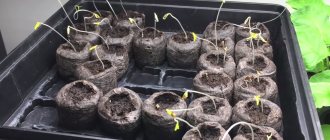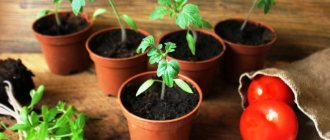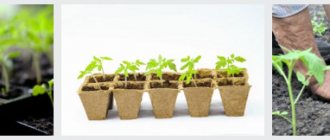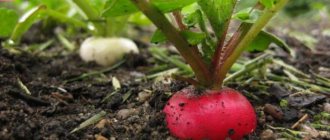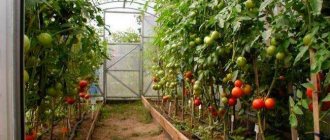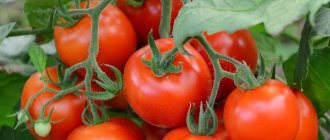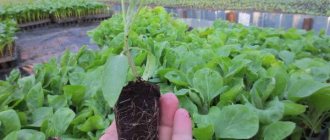- Rules for planting tomato seedlings in open ground
- When to plant tomato seedlings in open ground: preparing seedlings for planting
- When to plant tomato seedlings in the ground
- How to properly plant tomato seedlings in open ground
- Which tomato planting scheme to choose
- Early tomatoes
- Medium-ripening tomatoes and hybrids
- Late-ripening and indeterminate varieties of podir
- How to protect young tomato plantings from return frosts
- Video: when to plant tomato seedlings in the ground
Rules for planting tomato seedlings in open ground
In one of the articles we talked about how to grow tomato seedlings at home. In this article we will talk about the timing and rules of planting tomatoes in open ground.
How to grow tomato seedlings at home: rules for successfully growing seedlings in an apartment (read more)
Depending on the varietal group, the age of seedlings ready for planting in open ground is: for early tomatoes - 45-50 days, average ripening periods - 55-60, and late ones - at least 70 days. When planting seedlings at a younger age, the period of their adaptation to new conditions is significantly extended; the bushes develop poorly and are poorly resistant to disease and pests. But success in obtaining a high-quality tomato harvest also depends on carefully following the basic rules for planting seedlings in open ground .
Rules for planting tomato seedlings in open ground.
Choosing a landing site and preparing it
The planting site should be well lit, because tomatoes love light. Therefore, it is better to choose areas that are not shaded by neighboring trees or structures.
Regardless of where you will plant tomatoes (in a greenhouse or in open ground), it is advisable to place the beds on the site from east to west. With this placement, the tomatoes will be provided with uniform lighting and warming throughout the day.
Attention! It is not advisable to plant tomatoes in a greenhouse together with neighboring plants that need high humidity. For example, with cucumbers. Tomatoes get sick from high humidity.
Soil preparation consists of the following steps:
| Gardener actions | Execution Features |
| Soil disinfection | It is advisable to completely replace the soil in the greenhouse on which tomatoes were already grown last year. If this is not possible, then to disinfect the soil, pour boiling water or a solution of copper sulfate (at the rate of one tablespoon per liter of water). |
| Digging the soil and fertilizing it | Digging involves mechanically turning over layers of soil. When digging, it is advisable to add humus (up to 5-6 kg per square meter) and sprinkle the ground with ash or ashes (1 cup per square meter). |
When to plant tomato seedlings in open ground: preparing seedlings for planting
At least 5-6 days before planting (if the seedlings grew in an apartment), it is necessary to harden them (especially early tomatoes).
Before planting, it is useful to treat tomato seedlings with some preparation that will reduce the stressful effect of changing environmental conditions and help the plants take root (Zircon, Epin, NV-101 and others).
We grow tomatoes without seedlings - varieties, advantages and disadvantages of the method (read more)
It is important to carry out treatment with these products in full accordance with the instructions for the drug.
Growing and preparing seedlings
Before planting seeds for seedlings, you need to:
- treat the seeds in a solution of potassium permanganate;
- keep them in a growth stimulator solution.
Some manufacturers sell seeds already processed. Pay attention to the information on the packaging.
It is best to plant tomato seeds in peat pots (later it is convenient to replant the tomato along with the pot to a permanent place). If you don't have them, plastic cups or any other containers will do.
The depth of seed placement is one and a half to two centimeters. After sowing, the pots are covered with film (to create a microclimate favorable for seed germination) and placed in a warm place. When the shoots appear, they are brought out into the light (usually placed on the windowsill).
Important! Water the small sprouts carefully using settled water.
When the tomato has two true leaves, the plants are planted (picked) into separate containers, in which they remain to grow until planted in the main place.
When to plant tomato seedlings in the ground
Regardless of the region, tomato seedlings are planted in open ground when the soil in the 8-10 cm layer warms up to +10...+12°C (soil temperature measurements are taken for several days) and the reality of return frosts is minimized.
In temperate regions, it is better to plant tomato seedlings in so-called warm beds, or preheat the soil with hot water. To do this, 1-1.5 hours before planting the seedlings, pour 1-2 liters of hot water into each hole and temporarily cover the bed with any covering material. Only then are the seedlings planted.
The following data, based on many years of experience of gardeners in different regions of Russia, will help you roughly navigate the dates of planting tomato seedlings in open ground.
In the southern regions:
- Early tomatoes are usually planted from April 25 to May 10;
- medium and late ripening tomatoes - from 10.05 to 15.05.
In the Central Black Earth regions:
- early tomatoes - from May 25 to June 10;
- tomato seedlings of medium and late ripening periods - from 20.05 to 25.05 and from 1.06 to 10.06 (respectively).
Central Russia:
- early tomatoes - from 1.06 to 10.06;
- seedlings of medium and late ripening periods - from June 5 to June 15.
Ural and Siberian regions:
- seedlings of early tomatoes - from 5.06 to 10.06;
- middle and late varieties - from 5.06 to 15.06.
Regions of the Far East:
- early tomatoes - 1.05 to 25.05 (under cover);
- seedlings of medium and late varieties - from 10.06 to 25.06.
Note! In order for the seedlings to take root better and not get sunburn, they are planted from 10 to 12 and from 15 to 17 hours of the day or in cloudy (but not cool) weather.
If tomato seedlings have an open root system, planting is carried out vertically, without bending the root.
Secrets of caring for tomatoes
After the tomato seedlings take root in a new place, experienced tomato growers recommend carrying out a whole range of plant care measures to obtain a good harvest.
Among them:
- hilling;
- watering and fertilizing;
- stepsoning;
- garter;
- disease prevention;
- removal of leaves.
Hilling
Hilling up tomatoes will help strengthen the plant's root system. This should be done at the moment of root growth. Watch the tomato and it will tell you when it’s time for hilling.
Root buds (pimples) or a slight purple hue will appear above the ground at the base of the trunk or at the bottom of the trunk. This means that it is advisable to add a layer of earth to cover the ground part of the trunk. Soon, full-fledged roots will form there, which will improve the nutrition of the plant.
Watering
Tomatoes are considered a drought-resistant crop. But since in Russia they are grown mainly by seedlings, in which the plants’ root system is not as fully developed (as with the non-seedling planting method), the roots do not penetrate so deeply into the soil. As a result, the tomato itself cannot obtain the missing moisture from the depths of the earth. This means that it needs additional watering.
In the first two weeks after planting seedlings, watering should not be excessive . The plant must take root and develop its root system in a new location. If you overwater the tomatoes at this time, they will poorly develop their roots and most of them will remain in the surface layer of the soil.
Subsequently, tomatoes need to be watered on average 1-2 times a week. But it is better to focus on the weather and the condition of the plants. Experienced gardeners water tomatoes when the tips of the plant leaves begin to droop slightly. This is a signal that the water pressure inside the plant has decreased, and the tomato asks to be watered.
Garter
To tie a tomato means to give it additional support, to secure it. If the garter is not done, the tomato bush will either break or fall to the ground as it grows under its own weight.
Benefits of tying:
- the tomato bush remains fruitful and does not break;
- sunlight and air flows better between tied tomatoes;
- plants that do not lie on the soil surface are less likely to get sick;
- Fruits that fill and ripen on the ground are more often eaten by pests and rot.
- when tomato bushes are tied up, it is easier to care for them (water, fertilize, process, etc.).
In open ground, tomatoes are tied to pegs stuck into the ground next to the plant. In the greenhouse - vertically to the supports located under the ceiling.
Stepsoning
Competent and experienced tomato growers believe that tomatoes absolutely need pinching. They call it the process of removing additional shoots of the stem that form in the axils between the trunk and leaves of the tomato . The plants are inspected and the stepsons are plucked out with fingers.
Attention! If you remove the shoots in time, this will save the plant’s energy for growth and increase the quality of the harvest.
Top dressing
Fertilizing tomatoes increases productivity. It has been experimentally proven that when feeding tomatoes, you can harvest 20% more fruits than without it.
Three phases of tomato development in which fertilizing is done:
- The appearance of buds.
- Bloom.
- Fruit ripening.
There are two types of fertilizers:
- root (fertilizer is applied to the ground under the root of the tomato);
- foliar (the aerial part of the tomato is sprayed with a liquid fertilizer solution).
To increase productivity, tomato bushes are sprayed with a solution of boric acid (half a teaspoon per 10 liters of water).
Root feeding with yeast starter gives a good effect. To do this, ferment 100 g of fresh baker's yeast at room temperature with half a glass of sugar and two and a half liters of water. After fermentation is complete, the mixture is diluted at the rate of a glass of mash per bucket of water. The solution consumption is one liter per bush.
Removing leaves
You will need to remove leaves when the plants have grown greatly and their leaves begin to come into contact with each other or with the ground. Why pruning leaves is recommended:
- so that there is no transmission of diseases or pests between neighboring tomatoes;
- so that diseases do not develop on leaves in contact with the ground;
- to improve air circulation;
- so that the sun's rays penetrate better between the tomatoes;
- so that the plant’s strength and all nutrition go into the fruits, and not into the leaves.
Important! Until the fruit has set in the tomato cluster, you cannot remove the leaves above the cluster.
Leaves are pruned in dry weather. The plants are not watered immediately after pruning. This is done so that the wounds have time to dry and do not become a source of infection.
Protection from diseases and pests
The main way to combat diseases and pests is prevention. And it lies, first of all, in proper tillage of the soil before planting tomatoes. Before planting, the soil must be disinfected with boiling water or a solution of copper sulfate. Also, for preventive purposes, before planting seedlings, some gardeners advise adding a tablet of the special drug “Glyokladin” to the hole.
If pests, such as spider mites or caterpillars, appear on growing bushes, spraying with infusions of garlic or wormwood (200 g per liter of water) will help.
How to properly plant tomato seedlings in open ground
Tomato seedlings must be planted in compliance with the following requirements:
If tomato seedlings are grown in individual peat-humus or other pots , only the pot or earthen ball is deepened into the soil hole and covered with earth. The stem is not covered with soil. Engraftment is indicated by the appearance of new leaves. After 2 weeks, the first hilling is carried out to the height of the stem.
If tomato seedlings have an open root system , planting is carried out vertically, without bending the root, into a hole prepared in advance and abundantly watered. The plant placed in the center of the hole is carefully squeezed and mulched.
You can plant two plants in one hole, placing them along the row (this makes it more convenient to care for the plants).
If tomato seedlings are overgrown, it is more convenient to plant them obliquely along the row so that subsequent treatments do not damage the root system.
After planting, in the first 2-3 days the seedlings may “lie”. It `s naturally. There is no need to do anything.
The first post-planting watering is carried out no earlier than 10-12 days later (tomatoes cannot tolerate high humidity). But in case of very hot and dry weather, the first watering can and should be done earlier.
Suitable days for sowing tomatoes according to the lunar calendar in 2021 table
The grains are planted based on the lunar calendar. This is an old and proven method that has been used in our country for decades.
Traditionally, tomatoes are planted on the waxing moon.
Just below you will find a table where, for your convenience, we have compiled information about favorable days for planting tomato seeds in the ground. Data is presented for the first five months of 2021.
In addition to this, we added another line in which we collected already unsuccessful days for planting. These are the days of the new moon and full moon, on which usually no manipulations with seeds are carried out.
Table. List of good and bad days for sowing tomatoes according to the lunar calendar in 2021.
| Admissibility of work | January | February | March | April | May | June |
| Valid days | 14-27 | 12-26 | 14-27 | 13-26 | 12-25 | 11-23 |
| Invalid days | 13, 28 | 11, 27 | 13, 28 | 12, 27 | 11, 26 | 10, 24 |
What to do with dates for which there is no information in the table? These numbers are conventionally considered neutral for sowing tomatoes.
The fact is that they all fall on the waning moon. It is possible to sow in this phase, but the seeds germinate more slowly, and the seedlings grow worse and get sick more often.
However, it sometimes happens that you have to sow on a dying moon. In this case, just pay a little more attention to the seedlings.
Which tomato planting scheme to choose
To grow a good harvest of tomatoes, it is important to choose the right seedling planting scheme.
On a summer cottage, where beds in a crop rotation or a separate wedge are allocated for crops, you can use the following seedling planting schemes.
Early tomatoes
For example, I plant seedlings of early tomatoes in double rows or simply in rows. In a row scheme, so that the bushes do not shade each other (conditions are created for the development of fungal diseases) and do not thicken the plantings (it is more difficult to care for individual bushes in a row), I leave the distance between the bushes 45-50 cm, and between the rows 60-70 cm.
Low-growing tomatoes: the best varieties for growing in pots on balconies, window sills and mini-greenhouses in the ground (read more)
In the double row scheme, the distance between the ribbons is at least 70 cm (for tall plants - up to 1 m), and in the ribbon between the rows - 50-60 cm, in the row between bushes - 45-60 cm, depending on the varietal group.
Immediately after planting, I place arcs on which I secure covering materials used in case of temperature and weather deviations from the norm. I sprinkle the row spacing with sawdust, which helps preserve the fruits from contamination.
Neighborhood of tomatoes with other plantings
When placing and planning the location of beds on your site, you need to take into account the compatibility of different crops with each other.
In this regard, tomatoes go well with spinach, beans, carrots, radishes, asparagus, onions, radishes, lettuce, beets, zucchini, garlic, cabbage, pumpkin, celery, parsley, basil, marigolds, mint, sage, and calendula.
Basil goes perfectly with tomato. It protects it from parasites and helps improve the taste of the fruit. Garlic and radish protect tomatoes from spider mites and late blight, so gardeners often plant the sides of beds with these crops. Onions will be an excellent protector against flea beetles.
Asparagus effectively destroys nematodes, to which tomatoes are extremely susceptible. Proximity to gooseberry and bird cherry bushes will help prevent cutworms, moths and sawflies.
If the area is very windy, then beans will be able to protect the plant from the wind. But in this case, you should not choose tall varieties, since tomatoes grow and bear fruit poorly in the shade. In addition, any plantings located next to tomatoes will grow much more intensively, since this plant contains saponin, which effectively affects any planting crops.
Undesirable neighbors of tomatoes include:
- Potatoes, eggplants and peppers belong to the same nightshade group, which means they are susceptible to the same diseases (especially late blight). Therefore, these vegetable crops should be placed away from each other.
- Fennel and dill will deplete the soil and take all nutrients from neighbors.
- Corn - tall plants shade the beds, in addition, these crops attract the same pests.
- Turnips, grapes, sorrel and quinoa are also “bad” neighbors, as they negatively affect the development of tomatoes.
Late-ripening and indeterminate varieties of podir
I plant tomato seedlings of this group in a row method. I leave at least 70-80 cm in the row between the bushes and 1-1.5 m between the rows. Tomatoes grow up to 2 meters or more, so immediately after planting I pull 2-3 rows of wire or thick twine onto stakes (to form a trellis ). I form the bushes into 2 stems and constantly monitor timely gartering.
In cool regions, this scheme allows, as low temperatures approach at the end of summer, to cover the rows with straw, carefully remove the plants from the trellises and arrange them along the row. Install arches with covering material. At the same time, mature varieties of tomatoes (“Northern Miracle”, “Northern Beauty”, “Borodino F1”, etc.) will continue the formation and ripening of fruits on their native bush, which means you will receive a harvest for fresh use for much longer.
How to properly tie tomatoes
Let me introduce you to the main rules of garter:
- Use only disposable garter materials (to prevent fungal diseases).
- Before use, all supports are disinfected with a solution of potassium permanganate (0.02 g of the drug per 1 liter of water).
- Do not squeeze the stem with a bandage - this will disrupt the metabolism in its tissues.
- Tying is necessary at the stage when the bushes begin to bend to the ground under their weight.
I use hemp rope as a garter material. Wire, fishing line, ropes are not suitable for this. But old nylon tights work well. You can buy special clothespins and clips.
As for the support itself, there are several options:
- Individual. These are wooden stakes, iron rods, plastic tubes, which are placed next to each bush. The support should be approximately the same height as it. The device is not suitable for tall varieties.
- Horizontal trellises. Wooden stakes are driven between the rows at a distance of 1.5-2 meters. A wire or twine is stretched along their height at a distance of 30-40 cm. Tomatoes are already tied to it with scraps of fabric.
- Net. Between the rows, mesh sheets are installed, to the rods of which the tomatoes are attached with garter material or special clothespins.
There are also special store accessories: wire frames for each bush or pyramid caps.
garter pins
How to protect young tomato plantings from return frosts
If cold temperatures are expected at night and in the morning, and tomato seedlings have already been planted, then use temporary shelters until stable positive temperatures arrive (spunbond, lutrasil, etc.).
If the planted tomato seedlings are frozen, cut the stems and leaves to healthy tissue, and the remaining ones are sprayed with warm solutions of low concentration, iodine, and Zircon. This technique (if the roots are not damaged) stimulates growth processes well, and if the early harvest is lost, the overall yield will be quite high.
Spraying with anti-stress solutions "Epin" and "Zircon" can be repeated several times after 8-10 days. After 3-4 days, you need to fertilize with urea, “Kemira”) and after 5-7 days, repeat fertilizing with full fertilizer (nitrophoska or any other), but very carefully and in low doses.
If the freezing of the above-ground mass is insignificant (the leaves do not turn black, but seem to have withered), watering the leaves through a shallow diffuser with slightly warm water (literally at room temperature) has a positive effect. This technique promotes the gradual thawing of a slightly frozen bush.
Tomatoes die when the temperature drops from +3...+1°C to -1°C. To protect plants from prolonged cold spells, they are heated with smoky fires, and the bushes are covered with straw and dry sawdust. For small plantings, the bushes are covered with cardboard boxes, plastic containers or covering material.
How does the sign of the moon affect the germination of tomato seeds?
The moon has a noticeable effect on the development of plant seeds, including tomatoes. In the waxing moon phase, internal processes are activated aimed at the growth of the above-ground parts of tomatoes: leaves, stems, fruits. In the phase of the dying moon, on the contrary, processes are activated aimed at developing and strengthening the root system.
Moon phases
Thus, sowing seeds must be done on the waxing moon . The grains planted during this period germinate faster and form the above-ground part, which is necessary for the young plant for photosynthesis.
The dying moon phase is not the most favorable time for planting tomatoes, but if you have no other choice, you can sow on these days.
But it is not recommended to sow seeds the full and new moon phases
Astrology also gives its recommendations regarding the choice of the day for sowing. It is believed that the zodiac constellations Leo and Taurus have a beneficial effect on the growth of tomatoes. Therefore, on days when the moon passes through these constellations, it is best to land.
Aries is also favorable for planting tomatoes, but only for early varieties.
But the signs of Virgo and Aquarius negatively affect the germination of tomato seeds, so it is better not to sow on these days.
ON A NOTE. In 2021, the moon will pass through the constellations Virgo or Aquarius on the following dates of the first half of the year: January 4, 5, 14, 15, 16, 31, February 1, 11, 12, 26, 27, 28, 9, 10, 11, March 26, 27, 28, April 5, 6, 7, 22, 23, 24, May 2, 3, 4, 5, 30, 31 and June 1, 26, 27, 28.
